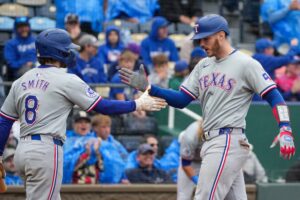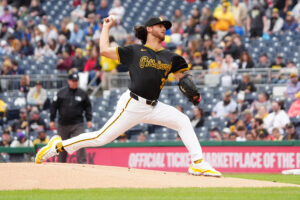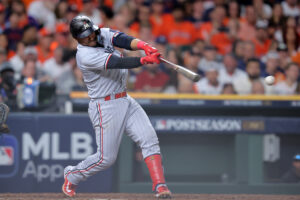Brandon Nimmo evolved from a liability to a defensive asset in the center field, thanks to defensive positioning adjustments. Since 2021, the Wisconsin native excelled by setting up deeper in center field, which allowed him to use his speed to get to more balls. Nimmo’s improvements significantly increased his value in free agency this past winter. Although he is still in his prime and under team control, are signs possibly pointing to the Mets targeting Cody Bellinger in free agency this offseason?
Sign 1: Nimmo in Left Field
Entering Thursday, Nimmo has started five straight games in left field as he manages a left quadricep strain. The injury popped up at the beginning of August and caused Nimmo to miss some games. Ideally, playing left (specifically having less ground to cover than in center) allows the injury to heal better without Nimmo missing more games.
Update: Brandon Nimmo defined his quad injury as a strain — not a bruise, as a Mets spokesman called it. He estimates that he's at about 85% capacity, and believes playing left field instead of center lessens his risk of aggravating it. Swinging a bat does not hurt Nimmo at all.
— Anthony DiComo (@AnthonyDiComo) August 12, 2023
While this makes sense, it’s easy to wonder if the Mets are preparing Nimmo to play left field on a more regular basis. He will be 31 next year and has a history of altering his game to protect his legs. In 2022, Nimmo declined to take advantage of his incredible speed on the bases to keep him healthy during the year.
But when Starling Marte got hurt last September, Nimmo wanted to make up for the loss and steal more bases. He stole three bags (his only three all year) in two weeks in September but left the game after his third steal due to “left quad tightness.”
It may be cynical, but the Mets aren’t playing Nimmo just for his immediate health. He is an integral part of the team; all parties know his importance on the field. 2023 is only his third season of playing in more than 100 games, so proactive protection makes sense.
There are six years left on his deal after this campaign. Although the center field is a more valuable position than the left, Nimmo is more practical on the left than on the IL. The Mets paid Nimmo to be a center fielder, but this ownership likely won’t let money get in the way of constructing the best overall roster. Nimmo should spend the next six weeks getting acclimated to left field and preparing in the offseason to play there more in 2024.
Sign 2: Mets Targeting Bellinger for His Defense
The Mets have yet to have an obvious center field replacement ready for Opening Day 2024. Bellinger represents the best option in free agency (better than anyone available via trade).
In his career, Bellinger has 13 Defensive Runs Saved and 23 Outs Above Average in over 3,500 center-field innings. Nimmo has -14 DRS and 10 OAA in over 3,900 center-field innings. When focusing just on the last three years to factor in Nimmo’s improvements, Bellinger still grades out as better.
The Mets saw the importance of team defense in 2022. Bellinger upgrades the center field defense while Nimmo upgrades it in left. In over 900 career innings, Nimmo has 8 DRS and 5 OAA in left.
Bellinger’s elite athleticism allows him to be above average at right field and first base. His last appearance in the right came in 2021, and his previous season of extensive time there was in 2019. He produced 18 DRS in the right and 3 in the center that season.
In 2023, Bellinger has 185 innings at first (entering Wednesday) with 4 DRS and 2 OAA. The Mets see just how valuable defensive versatility is for a roster through Jeff McNeil. Bellinger provides similar value, allowing New York to cycle players through the DH spot in the lineup. Teams typically prefer this flexibility with the DH spot, and the Mets will likely take advantage of it in 2024.
Cody Bellinger with a nice play !! 👏
(via @Cubs )pic.twitter.com/Z8onhz0JFs
— FOX Sports: MLB (@MLBONFOX) August 12, 2023
While the Mets should target Bellinger as a centerfielder in 2024, his versatility and athleticism allow him to remain a great fit on the roster in 2025 and beyond. If the team doesn’t extend him, he can replace Pete Alonso first in 2025. After Marte’s contract expires, he can also shift to the right field at age 30 in 2026.
Sign 3: Mets Targeting Bellinger for His Offense
When the Mets agreed to a deal with Carlos Correa this winter, owner Steve Cohen called him the “missing piece” to the lineup. While Correa famously isn’t a Met, Cohen’s lineup still needs at least one more significant piece. Bellinger could be that big piece in the middle of a bounce-back campaign with the Cubs.
In 88 games, Bellinger has a 148 wRC+ and .929 OPS. While these numbers are just below his 2019 MVP season, they still represent elite offensive production. Furthermore, his 15.4 strikeout percentage and 81.4 contact percentage mark career bests on par with his best seasons. This shows Bellinger’s resurgence stems from legitimate adjustments to his approach at the plate.
There are metrics in Bellinger’s profile that could raise red flags; first, his quality of contact. His percentile placement in Average Exit Velocity (17th), Barrel percentage (31st), and HardHit percentage (9) is awful. Additionally, his unsustainable .341 BABIP indicates luck might be driving some of Bellinger’s numbers.
Bellinger is not hitting the ball hard, and when he does put balls in play, they’re falling in. This is not a recipe for sustainable success and could foreshadow regression. However, this has remained the same for his power numbers this season. His Isolated Power (ISO) is .226. According to FanGraphs and ISO, around .140 is average, and premier sluggers typically have ISOs above .200.
CODY BELLINGER’S 17th HOME RUN 🚀 pic.twitter.com/7BVKt8m8Rd
— Chief Cub (@ChiefCub) August 9, 2023
The Mets need to determine what they believe Bellinger will be over the next several years. If his resurgence is real, his offensive potential fits perfectly in New York’s lineup.
Sign 4: Mets Targeting Bellinger for His Age
A lot has been said since the trade deadline regarding New York’s plan in 2024. Next season will be a transition year as the Mets gauge how their prospects develop. Max Scherzer told reporters that his understanding sees New York’s next contention window opening in 2025 at the earliest.
However, Ken Rosenthal of The Athletic reported last week that the Mets expect to be active this winter. The team won’t target high-priced stars on the wrong side of 30 but will be aggressive for players that will still be young when their prospects are ready to contribute. Though the article links the Mets to Yoshinobu Yamamoto, an ace in Japan that turns 25 this week, this logic also applies to Bellinger.
Yoshinobu Yamamoto’s curveball looks like something out of a video game. pic.twitter.com/ZdwKDhOylS
— Tyler Milliken ⚾️ (@tylermilliken_) August 9, 2023
Bellinger will be 28 on Opening Day next year. Mets top prospect Luisangel Acuna projects to make his debut sometime next year and is an infielder athletic enough to play center. Drew Gilbert is an above-average center fielder and projects to be ready in 2025.
If the Mets sign Bellinger, he will still be in his prime in 2026 as a 30-year-old. He’ll likely still be a good defender in the center but can shift to the right field if Acuna or Gilbert prove to be better. As mentioned, he could also go first with Nimmo on the left and Acuna and Gilbert in the other two spots.
If Yamamoto is the pitcher that fits the Mets’ timeline best on the pitching side, Bellinger is the best fit among position players.
How Likely Are the Mets to Sign Bellinger?
People are still determining what the Mets plan on doing this offseason. General manager Billy Eppler told reporters after the deadline that the team will be competitive next year but not runaway World Series favorites. Around the same time, Cohen said he would be competitive in looking for value this winter.
Bellinger fits the Mets, but he also does most teams. The Bellinger sweepstakes will probably result in a bidding war in a weak free agent class on the position player side. No other owner can compete with Cohen if he’s determined to get the player.
Cohen and the Mets will be one of the more intriguing stories to watch this offseason. Bellinger alone will not turn the team into World Series favorites. However, it would be a signing proving Cohen should never be counted out regarding stars. It would also make the Mets one of the deepest lineups in baseball.
Main Photo Credits: Vincent Carchietta-USA TODAY Sport






